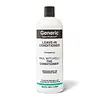What's inside
What's inside
 Key Ingredients
Key Ingredients

 Benefits
Benefits

 Concerns
Concerns

 Ingredients Side-by-side
Ingredients Side-by-side

Water
Skin ConditioningCetyl Alcohol
EmollientStearyl Alcohol
EmollientGlycerin
HumectantCetrimonium Bromide
AntimicrobialBisamino PEG/PPG-41/3 Aminoethyl Pg-Propyl Dimethicone
Parfum
MaskingPEG-12 Dimethicone
Skin ConditioningSoyamidopropyl Ethyldimonium Ethosulfate
Propylene Glycol
HumectantCitric Acid
BufferingAloe Barbadensis Leaf Extract
EmollientAnthemis Nobilis Flower Extract
MaskingBlue 1 Lake
Cosmetic ColorantAlgae Extract
EmollientRosmarinus Officinalis Leaf
Skin ConditioningSimmondsia Chinensis Seed Cera
EmollientMethylchloroisothiazolinone
PreservativeMethylisothiazolinone
PreservativeButylphenyl Methylpropional
PerfumingCitronellol
PerfumingCoumarin
PerfumingGeraniol
PerfumingHexyl Cinnamal
PerfumingLimonene
PerfumingLinalool
PerfumingWater, Cetyl Alcohol, Stearyl Alcohol, Glycerin, Cetrimonium Bromide, Bisamino PEG/PPG-41/3 Aminoethyl Pg-Propyl Dimethicone, Parfum, PEG-12 Dimethicone, Soyamidopropyl Ethyldimonium Ethosulfate, Propylene Glycol, Citric Acid, Aloe Barbadensis Leaf Extract, Anthemis Nobilis Flower Extract, Blue 1 Lake, Algae Extract, Rosmarinus Officinalis Leaf, Simmondsia Chinensis Seed Cera, Methylchloroisothiazolinone, Methylisothiazolinone, Butylphenyl Methylpropional, Citronellol, Coumarin, Geraniol, Hexyl Cinnamal, Limonene, Linalool
Water
Skin ConditioningCetearyl Alcohol
EmollientBehentrimonium Chloride
PreservativeCyclopentasiloxane
EmollientQuaternium-80
Parfum
MaskingDMDM Hydantoin
PreservativeMethylparaben
PreservativeEthylparaben
PreservativePanthenol
Skin ConditioningPropylene Glycol
HumectantSilk Amino Acids
HumectantIodopropynyl Butylcarbamate
PreservativeHelianthus Annuus Extract
EmollientButylene Glycol
HumectantCamellia Sinensis Leaf Extract
AntimicrobialBenzyl Benzoate
AntimicrobialCitronellol
PerfumingHexyl Cinnamal
PerfumingIsoeugenol
PerfumingLimonene
PerfumingLinalool
PerfumingWater, Cetearyl Alcohol, Behentrimonium Chloride, Cyclopentasiloxane, Quaternium-80, Parfum, DMDM Hydantoin, Methylparaben, Ethylparaben, Panthenol, Propylene Glycol, Silk Amino Acids, Iodopropynyl Butylcarbamate, Helianthus Annuus Extract, Butylene Glycol, Camellia Sinensis Leaf Extract, Benzyl Benzoate, Citronellol, Hexyl Cinnamal, Isoeugenol, Limonene, Linalool
Ingredients Explained
These ingredients are found in both products.
Ingredients higher up in an ingredient list are typically present in a larger amount.
Citronellol is used to add fragrance/parfum to a product. It is often derived from plants such as roses. In fact, it can be found in many essential oils including geranium, lavender, neroli, and more. The scent of Citronellol is often described as "fresh, grassy, and citrus-like".
Since the Citronellol molecule is already unstable, Citronellol becomes irritating on the skin when exposed to air.
Citronellol is a modified terpene. Terpenes are unsaturated hydrocarbons found in plants. They make up the primary part of essential oils.
Citronellol is not able to be absorbed into deeper layers of the skin. It has low permeability,
Citronellol is also a natural insect repellent.
Learn more about CitronellolHexyl Cinnamal is a fragrance ingredient with a similar scent to jasmine. It can be naturally found in chamomile essential oil.
This ingredient is a known EU allergen and may sensitize the skin. The EU requires this ingredient to be listed separately on an ingredients list.
Hexyl Cinnamal is not water soluble but is soluble in oils.
Learn more about Hexyl CinnamalLimonene is a fragrance that adds scent and taste to a formulation.
It's found in the peel oil of citrus fruits and other plants such as lavender and eucalyptus. The scent of limonene is generally described as "sweet citrus".
Limonene acts as an antioxidant, meaning it helps neutralize free radicals.
When exposed to air, oxidized limonene may sensitize the skin. Because of this, limonene is often avoided by people with sensitive skin.
The term 'fragrance' is not regulated in many countries. In many cases, it is up to the brand to define this term. For instance, many brands choose to label themselves as "fragrance-free" because they are not using synthetic fragrances. However, their products may still contain ingredients such as essential oils that are considered a fragrance.
Learn more about LimoneneLinalool is a fragrance and helps add scent to products. It's derived from common plants such as cinnamon, mint, citrus, and lavender.
Like Limonene, this ingredient oxidizes when exposed to air. Oxidized linalool can cause allergies and skin sensitivity.
This ingredient has a scent that is floral, spicy tropical, and citrus-like.
Learn more about LinaloolParfum is a catch-all term for an ingredient or more that is used to give a scent to products.
Also called "fragrance", this ingredient can be a blend of hundreds of chemicals or plant oils. This means every product with "fragrance" or "parfum" in the ingredients list is a different mixture.
For instance, Habanolide is a proprietary trade name for a specific aroma chemical. When used as a fragrance ingredient in cosmetics, most aroma chemicals fall under the broad labeling category of “FRAGRANCE” or “PARFUM” according to EU and US regulations.
The term 'parfum' or 'fragrance' is not regulated in many countries. In many cases, it is up to the brand to define this term.
For instance, many brands choose to label themselves as "fragrance-free" because they are not using synthetic fragrances. However, their products may still contain ingredients such as essential oils that are considered a fragrance by INCI standards.
One example is Calendula flower extract. Calendula is an essential oil that still imparts a scent or 'fragrance'.
Depending on the blend, the ingredients in the mixture can cause allergies and sensitivities on the skin. Some ingredients that are known EU allergens include linalool and citronellol.
Parfum can also be used to mask or cover an unpleasant scent.
The bottom line is: not all fragrances/parfum/ingredients are created equally. If you are worried about fragrances, we recommend taking a closer look at an ingredient. And of course, we always recommend speaking with a professional.
Learn more about ParfumPropylene Glycol is an odorless, colorless liquid. As a humectant, it helps skin retain moisture. It also aids in delivering active ingredients.
Another role of this ingredient is preventing a product from melting or freezing. Propylene glycol also adds antimicrobrial properties to a product, elongating product lifespan.
This ingredient is considered an organic alcohol and commonly added into both cosmetics and foods.
Those with sensitive skin or conditions may develop a rash when using this ingredient.
Learn more about Propylene GlycolWater. It's the most common cosmetic ingredient of all. You'll usually see it at the top of ingredient lists, meaning that it makes up the largest part of the product.
So why is it so popular? Water most often acts as a solvent - this means that it helps dissolve other ingredients into the formulation.
You'll also recognize water as that liquid we all need to stay alive. If you see this, drink a glass of water. Stay hydrated!
Learn more about Water